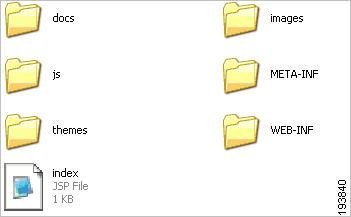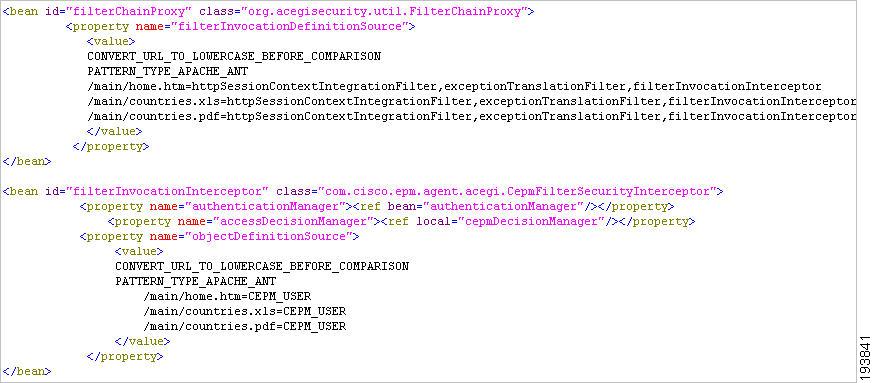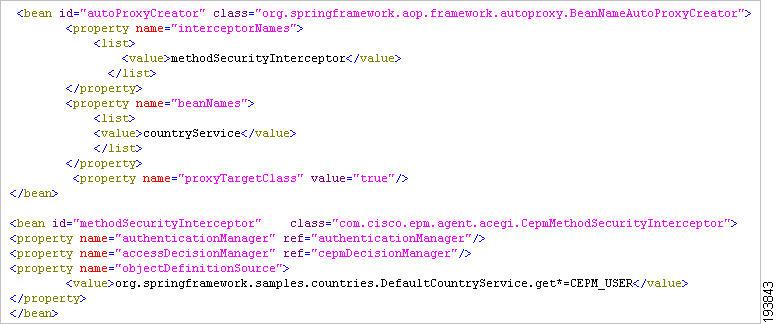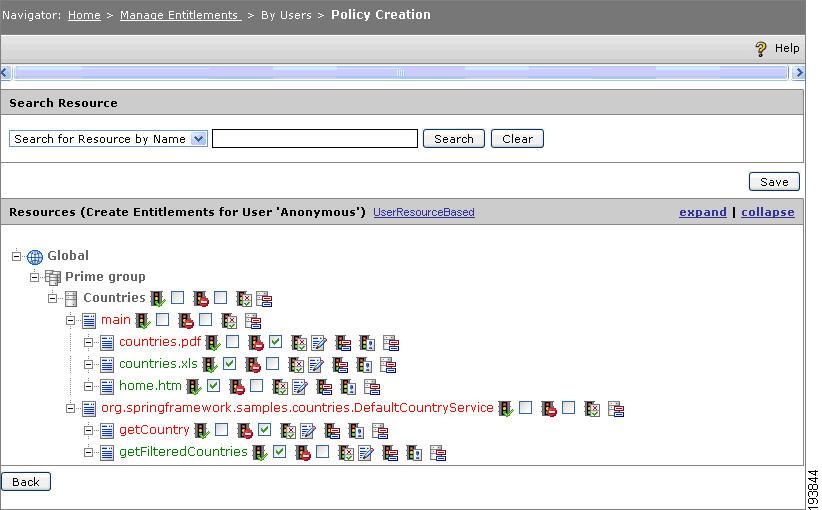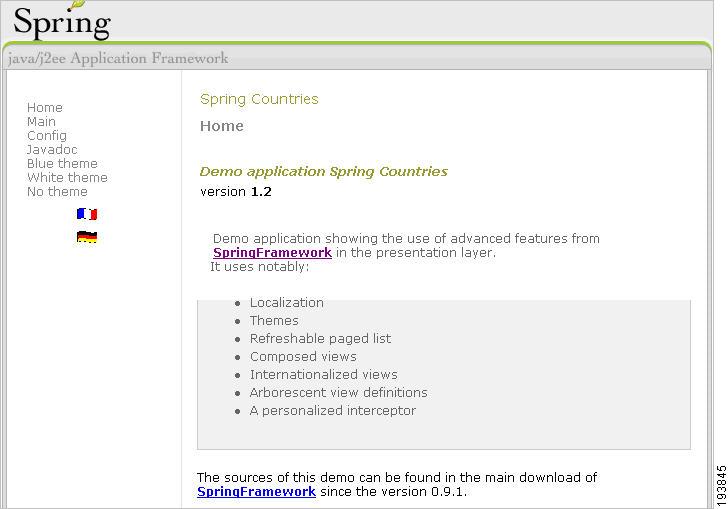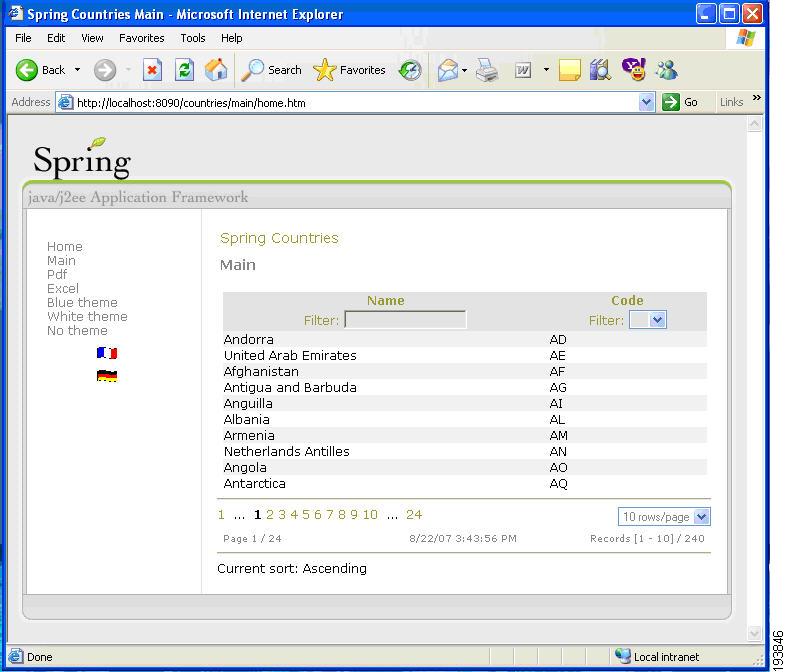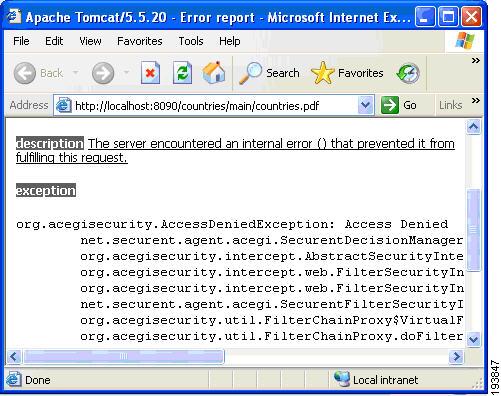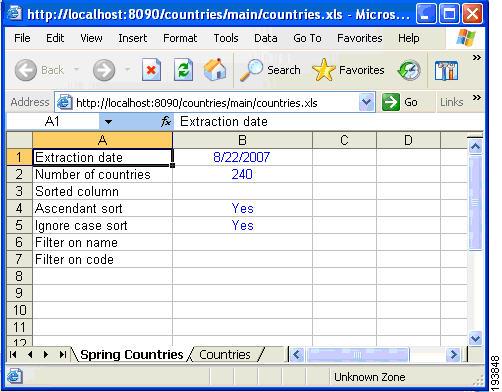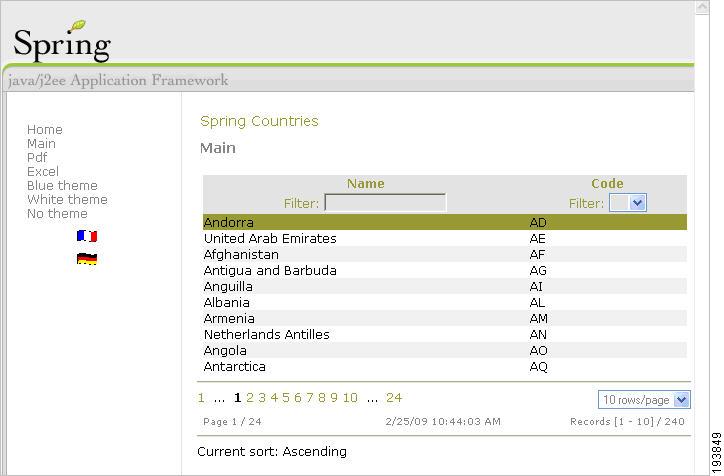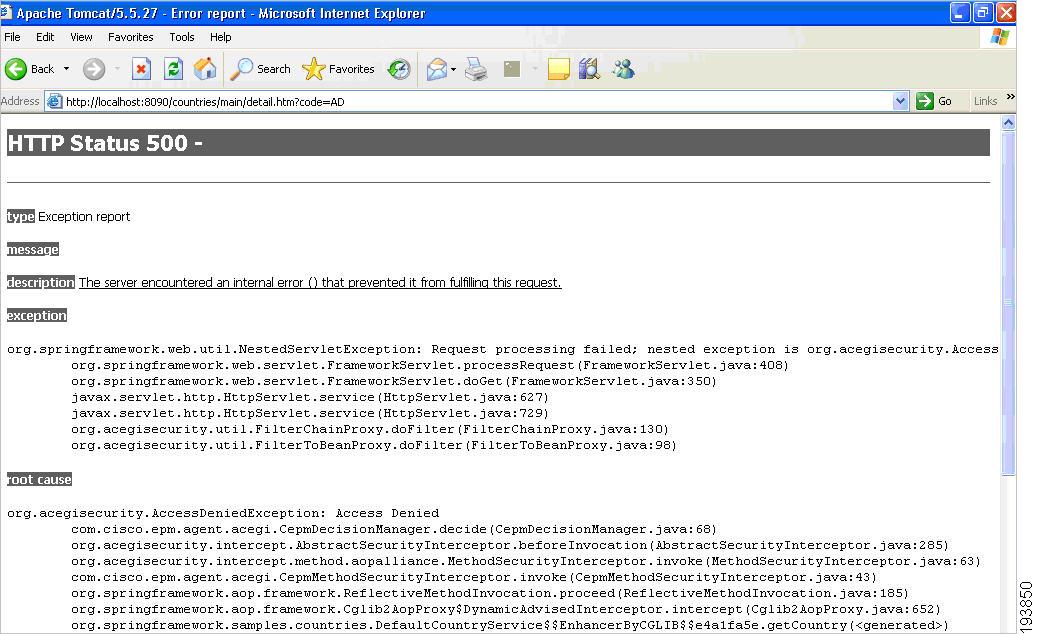 Feedback Feedback
|
Table Of Contents
Integrating CEPM ACEGI Agent with a Web Application
Integrating the ACEGI Agent in a Static Application (Using In-Process PDP)
Configuring ACEGI Agent with a Sample Spring Application
Obtaining Documentation and Submitting a Service Request
CEPM ACEGI Agent Guides
Revised: January 17, 2011, Doc Part No: OL-19562-01Contents
•
Integrating CEPM ACEGI Agent with a Web Application
•
Integrating the ACEGI Agent in a Static Application (Using In-Process PDP)
•
Configuring ACEGI Agent with a Sample Spring Application
•
Obtaining Documentation and Submitting a Service Request
About This Document
Objective
This document provides guidelines for deployment of the ACEGI agent and it explain using Cisco customized ACEGI authorization solution for applications running in the Spring Framework. It also provides a step-by-step procedure for the integration of ACEGI agent in static applications with in-process Policy Decision Point (PDP) configuration.
Audience
This guide is for administrators who use CEPM and are responsible for resource modelling and entitlement management.
ACEGI Approach
ACEGI Security provides comprehensive security services for Java 2 Platform, Enterprise Edition (J2EE)-based enterprise software applications, particularly applications using the Spring Framework. ACEGI provides a strong security cover to these applications while switching server environments, where the user must reconfigure the security features.
ACEGI stipulates the authentication as well as authorization features of an application. To make the security cover more explicable and stronger, the security configuration is customized in terms of Cisco Enterprise Policy Manager (CEPM) functionalities, which will henceforth attend to the authorization part assuming that ACEGI still meets the authentication feature.
When a user tries to access a Spring-based security implementation, the ACEGI authenticates the user, but CEPM authorizes the user by using customized accessibility features.
For example, in a banking application protected by ACEGI, user Mary has access only to Report6. To make the authorization process more stringent, the user info of Mary is reconfigured using the advanced features of CEPM. For example, a rule-based policy is created for Report6 involving things such as utsertype and user attributes. When Mary tries to access Report6, assuming that the login authentication has already been done by ACEGI, the authorization permission is delivered by CEPM.
Integrating CEPM ACEGI Agent with a Web Application
To integrate the ACEGI agent with a web application, follow these steps:
Step 1
Unzip the distribution, CEPM_ACEGIAgentV3.3.0.0.zip, from the distribution folder.
In this document, the directory where this zip file is unzipped is referred to as the ACEGI_HOME directory.
Step 2
Copy libraries acegi_agent.jar, acegi-security-1.0.3.jar, cglib-nodep-2.1_3.jar, pep.jar, CEPM_Commons.jar and papclient.jar from ACEGI_HOME directory to PROJECTHOME\WEB-INF\lib directory where PROJECTHOME is the root directory of the web application.
Step 3
Edit pep_config.xml and update the values of <applicationgroup> and <application> tags to the application group and web-application for which you want to check the permissions. Modify URL value of <pdp> to the url on which PDP Server is running. Also update url value of <api> to the url on which PAP Server is running.
Step 4
Add CEPM_AGENT_CONFIG, log4j.configuration and CEPM_DECISION_CACHE_CONFIG elements to Java property for specifying the pep_config.xml path, logging.xml and jbosscache.xml files. For example:
-DCEPM_AGENT_CONFIG=$ACEGI_HOME\config\pep\pep_config.xml-Dlog4j.configuration=$ACEGI_HOME\config\logging\logging.xml -DCEPM_DECISION_CACHE_CONFIG=$ACEGI_HOME\config\jbosscache\jbosscache.xml
Note
For in-process PDP, you must specify the directory path of the pdp_config.xml file instead of pep_config.xml file.
Step 5
Open the PROJECTHOME\WEB-INF\web.xml file and add the following filter entries before </web-app> tag:
<filter><filter-name>Acegi Filter Chain Proxy </filter-name><filter-class>org.acegisecurity.util.FilterToBeanProxy</filter-class><init-param><param-name>targetClass</param-name><param-value>org.acegisecurity.util.FilterChainProxy</param-value></init-param></filter><filter-mapping><filter-name>Acegi Filter Chain Proxy</filter-name><url-pattern>/*</url-pattern></filter-mapping>Step 6
To configure CEPM ACEGI Security, add following tags in Spring configurations file which is by default PROJECTHOME\WEB-INF\applicationContext.xml. Add following bean entries between <beans> and </beans> tags.
<bean id="cepmDecisionManager" class="com.cisco.epm.agent.acegi.CepmDecisionManager"><property name="resourceManager"><bean class="com.cisco.epm.agent.acegi.CepmSecurityResourceManager"/></property></bean>Step 7
To protect URLs, edit the Spring configurations file, which is located in PROJECTHOME\WEB-INF\applicationContext.xml by default in the following ways:
a.
Add the following bean entries between the <beans> and </beans> tags:
<bean id="filterChainProxy" class="org.acegisecurity.util.FilterChainProxy"><property name="filterInvocationDefinitionSource"><value>CONVERT_URL_TO_LOWERCASE_BEFORE_COMPARISON PATTERN_TYPE_APACHE_ANT URL_pattern=filterInvocationInterceptor</value></property></bean><bean id="httpSessionContextIntegrationFilter" class="org.acegisecurity.context.HttpSessionContextIntegrationFilter"/><bean id="filterInvocationInterceptor" class="com.cisco.epm.agent.springsecurityrolevoter.CepmFilterSecurityInterceptor"><property name="authenticationManager"><ref bean="authenticationManager"/></property><property name="accessDecisionManager"><ref local="cepmDecisionManager"/></property><property name="objectDefinitionSource"><value>CONVERT_URL_TO_LOWERCASE_BEFORE_COMPARISON PATTERN_T YPE_APACHE_ANT URL_pattern=role_allowed</value></property></bean><bean id="exceptionTranslationFilter" class="org.acegisecurity.ui.ExceptionTranslationFilter"><property name="authenticationEntryPoint"><ref local="authenticationProcessingFilterEntryPoint"/></property></bean><bean id="authenticationManager" class="org.acegisecurity.providers.ProviderManager"><property name="providers"><list><ref local="anonymousAuthenticationProvider"/></list></property></bean><bean id="anonymousAuthenticationProvider" class="org.acegisecurity.providers.anonymous.AnonymousAuthenticationProvider"><property name="key"><value>test</value></property></bean><bean id="authenticationProcessingFilterEntryPoint" class="org.acegisecurity.ui.webapp.AuthenticationProcessingFilterEntryPoint"><property name="loginFormUrl"><value>/index.jsp</value></property><property name="forceHttps"><value>false</value></property></bean>b.
Update the following bean entries:
–
In the bean entry with id = 'filterChainProxy', replace 'URL_pattern' with URL pattern to be secured in lower case.
Example:
/* or /log/portfolio.htm
–
In the bean entry with id = 'filterInvocationInterceptor', replace 'URL_pattern' with URL pattern to be secured in lower case.
Example:
/* or /log/portfolio.htm
–
Replace 'role_allowed' with the role specified in the class, which implements 'Authentication' interface. While using the sample implementation provided with the agent, which is 'CepmAuthentication', then the value of 'role_allowed' should be 'CEPM_USER'.
–
In the bean entry with id = 'authenticationProcessingFilterEntryPoint', replace 'loginFormUrl' with URL, which should be displayed, if the user requests a secure HTTP resource but is not authenticated.
Step 8
To protect the methods, edit the Spring configurations file, which is (by default) located at PROJECTHOME\WEB-INF\applicationContext.xml in the following way:
a.
Add the following bean entries after the <beans> tags:
<bean id="autoProxyCreator" class="org.springframework.aop.framework.autoproxy.BeanNameAutoProxyCreator"><property name="interceptorNames"><list><value>Interceptor_Names</value></list></property><property name="beanNames"><list><value>Bean_Names</value></list></property><property name="proxyTargetClass" value="true"/></bean><bean id="Interceptor_Name" class="com.cisco.epm.agent.springsecurityrolevoter.CepmMethodSecurityInterceptor"><property name="authenticationManager" ref="authenticationManager"/><property name="accessDecisionManager" ref=" cepmDecisionManager"/><property name="objectDefinitionSource"><value>Method=role_allowed</value></property></bean>b.
Update the following bean entries:
–
In the bean entry with id = 'Interceptor_Name',replace 'Method' with the methods to be secured.
Example:
com.devx.tradingapp.web.PortfolioItemBean.setGainLoss (or) com.devx.tradingapp.web.PortfolioItemBean.set–
In the bean entry with id = 'Interceptor_Name', replace 'role_allowed' with the role specified in the class which implements 'Authentication' interface. For example, if you are using sample implementation provided with the agent (which is `CEPMAuthentication') then the value of 'role_allowed' should be 'CEPM_USER'.
–
In the bean entry with id = 'Interceptor_Name', replace 'Interceptor_Name' with any unique name.
Example:
methodSecurityInterceptor
–
In the bean entry with id = 'autoProxyCreator', replace 'Interceptor_Names' with interceptorName/s (typically these are bean id values for interceptors that are to be secured and Bean_Names to its associated bean.
Example:
<bean id="portfolioBean"class="com.devx.tradingapp.web.PortfolioItemBean"></bean>then update 'Bean_Names' to 'portfolioBean'
Step 9
If you want to consider the logged in user of the Spring Application:
a.
Add the following code before the return statement in the handleRequest() method of the controller, which handles a request coming from login page. Add this between the code which authenticates the user and return statement. The code assumes that a user is a authenticated user.
* Statement which will create object of the class which implements 'Authentication' interface, say 'auth' based on the user information coming from login page like username,password etc.('CepmAuthentication' provided with agent reqiuires only username)* Add the following statements:HttpSession httpSession = ((HttpServletRequest) httpServletRequest).getSession();//Where httpServletRequest is an object of type HttpServletRequestorg.acegisecurity.context.SecurityContext sc=org.acegisecurity.context.SecurityContextHolder.getContext();sc.setAuthentication(auth);// where 'auth' is an object created in above stephttpSession.setAttribute("ACEGI_SECURITY_CONTEXT",sc);b.
If you want to use a sample controller provided with the agent, follow these steps:
–
Edit SampleAcegiController.java and modify the contents by referring the inline comments.
–
Put servlet.jar, acegi-security.jar and acegi_agent.jar files in the classpath and compile it.
–
Copy the complied class to the PROJECTHOME\WEB-INF\classes directory.
–
Copy SampleAcegi-servlet.xml to the PROJECTHOME\WEB-INF directory.
–
Edit SampleAcegi-servlet.xml and modify the value of 'key' in <prop> tag to the page starting with '/' which should display after login.
Step 10
Restart the server and run the web application.
When an authenticated user tries to access a secured resource (for example, a Java Server Page), depending on the permissions specified within CEPM, either the requested resource is displayed or an AccessDeniedException is thrown to indicate access is denied.
Note
To create these resources in 'CEPM', set the <record></record> value to "true" in the pep_config.xml file.
Integrating the ACEGI Agent in a Static Application (Using In-Process PDP)
If you are using the in-process PDP, the PEP configurations are accommodated in pdp_config.xml file. No pep_config.xml file exists. The process of integrating the ACEGI agent with in-process PDP is similar to the process for integrating the ACEGI agent with a web application, with changes in Steps 1 to 3.
To integrate the ACEGI agent with in-process PDP configurations in the static application running in Spring Framework, follow these steps:
Step 1
Unzip the distribution, ACEGIAgentV3.3.0.0_InProcessPDP.zip, from the distribution folder.
In this document, the directory where this zip file is unzipped is referred to as the ACEGI_HOME directory.
Step 2
Copy libraries spring.jar, acegi_agent.jar, acegi_security.jar, InProcessPDP.jar, thirdpartylib_inprocess.jar and papclient.jar from ACEGI_HOME directory to PROJECTHOME\WEB-INF\lib directory, where PROJECTHOME is the root directory of the web application.
Note
For MSSQL database, also copy the sqljdbc.jar file. For IBM DB2, also copy the db2jcc.jar, db2jcc_javax.jar and db2jcc_license_cu.jar files.
Step 3
Edit pdp_config.xml from ACEGI_HOME\config\pdp folder and update the values of <applicationgroup> and <application> tags to the application group and web application for which you want to check the permissions.
Step 4
Add CEPM_AGENT_CONFIG and log4j.configuration to Java property for specifying the pdp_config.xml and jbosscache.xml path.
For example:
-DCEPM_AGENT_CONFIG=$ACEGI_HOME\config\pep\pep_config.xml-Dlog4j.configuration=$ACEGI_HOME\config\logging\logging.xml -DCEPM_DECISION_CACHE_CONFIG=$ACEGI_HOME\config\jbosscache\jbosscache.xmlTo complete this process, refer Step 5 of "Integrating CEPM ACEGI Agent with a Web Application".
Configuring ACEGI Agent with a Sample Spring Application
Follow the steps below to configure and test the countries Spring application using ACEGI to protect URLs and methods.
Step 1
Unpack `countries.war', the package structure looks like:
Figure 1 Folder structure
Step 2
Deploy countries.war in your application server.
Step 3
To protect .../main/home.htm, .../main/countries.pdf and .../main/countries.xls URLs, modify applicationContext.xml as follows:
Figure 2
applicationContext.xml
Step 4
To protect methods
Figure 3
Method
Modify applicationContext.xml as follows:
Figure 4 applicationContext.xml
Step 5
Edit pep_config.xml file and update applicationgroup and application to:
<applicationgroup>Prime group</applicationgroup><application>Countries</application>Step 6
To protectURLs and methods, the entitlements in CEPM for this application should be:
Figure 5 Policy Creation
Step 7
Run the application (for ex: http://host:port/countries).
Figure 6
Spring Framework
Step 8
Click Main tab in the left navigation pane.
URL resource .../main/home.htm and Method "getFilteredCountries" will be protected and
•
Decision for User 'Anonymous' for resource 'Prime group:Countries:main:home.htm' with action 'any' is 'Permit.'
•
Decision for User 'Anonymous' for resource 'Prime group:Countries:org.springframework.samples.countries.DefaultCountryService:getFilteredCountries' with action 'any' is 'Permit.
Figure 7 Spring Framework Hom e page
.
Step 9
Click Pdf tab in the left navigation pane.
URL resource /main/countries.pdf is protected. Decision for User 'Anonymous' for resource 'Prime group:Countries:main:countries.pdf' with action 'any' is:- 'Deny. As the permission is deny, Access Denied Exception will be thrown.
Figure 8 Access Denied Exception
Step 10
Click Excel tab in the left navigation pane.
URL resource /main/countries.xls is protected. Decision for User 'Anonymous' for resource 'Prime group:Countries:main:countries.xls' with action 'any' is 'Permit'.
Figure 9 Country.xls
Step 11
Select country `Andorra' as shown below. Method `getCountry' will be protected.
Figure 10
Protected Country and Method
Decision for User 'Anonymous' for resource 'Prime group:Countries:org.springframework.samples.countries.DefaultCountryService:getCountry' with action 'any' is:- 'Deny'. As the permission is deny, AccessDenied Exception will be thrown.
Figure 11 AccessDenied Exception
Documentation Updates
Table 1 Updates to CEPM ACEGI Agent Guides
July 9, 2009
Minor edits and template/boilerplate updates for publication to Cisco.com
April 3, 2009
Cisco Enterprise Policy Manager (EPM) Release 3.3.0.0
Related Documentation
CEPM_User_Guide_V3.3.0.0.pdf
Obtaining Documentation and Submitting a Service Request
For information on obtaining documentation, submitting a service request, and gathering additional information, see the monthly What's New in Cisco Product Documentation, which also lists all new and revised Cisco technical documentation, at:
http://www.cisco.com/en/US/docs/general/whatsnew/whatsnew.html
Subscribe to the What's New in Cisco Product Documentation as a Really Simple Syndication (RSS) feed and set content to be delivered directly to your desktop using a reader application. The RSS feeds are a free service and Cisco currently supports RSS Version 2.0.
CCDE, CCENT, CCSI, Cisco Eos, Cisco Explorer, Cisco HealthPresence, Cisco IronPort, the Cisco logo, Cisco Nurse Connect, Cisco Pulse, Cisco SensorBase, Cisco StackPower, Cisco StadiumVision, Cisco TelePresence, Cisco TrustSec, Cisco Unified Computing System, Cisco WebEx, DCE, Flip Channels, Flip for Good, Flip Mino, Flipshare (Design), Flip Ultra, Flip Video, Flip Video (Design), Instant Broadband, and Welcome to the Human Network are trademarks; Changing the Way We Work, Live, Play, and Learn, Cisco Capital, Cisco Capital (Design), Cisco:Financed (Stylized), Cisco Store, Flip Gift Card, and One Million Acts of Green are service marks; and Access Registrar, Aironet, AllTouch, AsyncOS, Bringing the Meeting To You, Catalyst, CCDA, CCDP, CCIE, CCIP, CCNA, CCNP, CCSP, CCVP, Cisco, the Cisco Certified Internetwork Expert logo, Cisco IOS, Cisco Lumin, Cisco Nexus, Cisco Press, Cisco Systems, Cisco Systems Capital, the Cisco Systems logo, Cisco Unity, Collaboration Without Limitation, Continuum, EtherFast, EtherSwitch, Event Center, Explorer, Follow Me Browsing, GainMaker, iLYNX, IOS, iPhone, IronPort, the IronPort logo, Laser Link, LightStream, Linksys, MeetingPlace, MeetingPlace Chime Sound, MGX, Networkers, Networking Academy, PCNow, PIX, PowerKEY, PowerPanels, PowerTV, PowerTV (Design), PowerVu, Prisma, ProConnect, ROSA, SenderBase, SMARTnet, Spectrum Expert, StackWise, WebEx, and the WebEx logo are registered trademarks of Cisco and/or its affiliates in the United States and certain other countries.
All other trademarks mentioned in this document or website are the property of their respective owners. The use of the word partner does not imply a partnership relationship between Cisco and any other company. (1002R)
Any Internet Protocol (IP) addresses and phone numbers used in this document are not intended to be actual addresses and phone numbers. Any examples, command display output, network topology diagrams, and other figures included in the document are shown for illustrative purposes only. Any use of actual IP addresses or phone numbers in illustrative content is unintentional and coincidental.
© 2009 Cisco Systems, Inc. All rights reserved.

